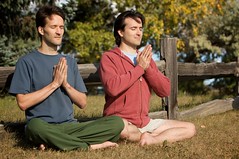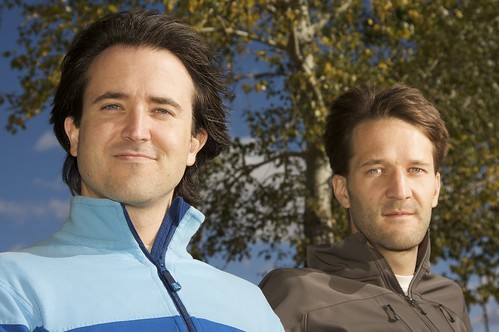
We ended up starting the shoot at 3PM with clear skies and full on sun! The day didn't start out that way of course. I preferred the conditions in the morning and for most of the day where it was bright but overcast. It's like having a giant softbox. But it's Calgary so a particular weather pattern typically never hangs around long enough to be useful.
I was not going to have the brothers staring in to the sun so it was understood from the beginning that fill flash was going to be necessary. I wanted limited depth of field, which meant shooting my 24-105mm f/4.0L wide open. It was evident from the first few test shots that normal maximum flash sync speed of 1/250th of a second was not going to cut it. The test shots were well above that.
I needed a new best friend, quick! The new best friend was high-speed sync. According to the Canon 580EX II manual, high-speed sync flash can synchronize with all shutter speeds and is no longer limited to 1/250th of a second. Cool. The short answer on the difference between normal flash and high-speed sync is with normal flash it is a single, quick burst of light. High-speed sync on the other hand the flash is continually pulsed at a lower power setting creating almost continuous lighting. Normal flash will freeze motion because it is a one-shot, quick burst of light. High-speed sync acts more like continuous lighting so it does not have the same "freeze" properties of normal flash but because you are typically using it at much, much faster shutter speeds, the subject will likely get frozen by the shutter speed. The other caveat is that high-speed sync fires the flash at lower power to maintain the pulsing action so the range is limited. But considering you can sync at any shutter speed, I for one am willing to live with the shortened range. Oh, and, if it wasn't obvious the flash needs to be in ETTL mode so that means it is tethered to or on top of the camera.
So with the flash set to ETTL and high-speed sync I could snap away and not worry about the shutter speed. Nice! I popped a 1/4 cut of CTO (colour temperature orange) on the bare flash for a bit of warmth and I was good to go. For these types of shots I generally set the exposure compensation to one stop (EV -1) below the metered value. Then I use flash exposure compensation (FEC) to bring the the light on my subject up to my liking. You end up with roughly a one stop difference between the background and the subject, which helps to pop the subject off of the background.
My explanation of high-speed sync flash is pretty simple. Ralph Paonessa has a great page on high-speed sync flash here.

Namaste.


No comments:
Post a Comment